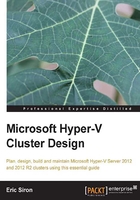
Chapter 1. Hyper-V Cluster Orientation
Microsoft Hyper-V Server 2012 or its R2 successor in a Microsoft Failover Cluster configuration is one of the most powerful infrastructure tools available for system administrators. It provides an inexpensive solution that combines all the benefits of virtualization with the resiliency and resource-spreading capabilities of clustering. While the technologies can provide substantial advantages, designing and implementing a Hyper-V Server failover cluster is not a trivial undertaking.
Before you can begin designing your cluster, it's important to orient yourself to the scope of the task that you're committing to. It is imperative that you master the fundamentals of the technologies involved in a Hyper-V Server cluster. You must also thoroughly understand the problem that you are using a Hyper-V Server cluster to solve. Based on that problem, you must define a clear set of goals that such a system must achieve in order to serve as a proper solution. You will then design a cluster that can meet those goals. After that, you can build, test, and deploy your Hyper-V cluster.
By the end of this chapter, you will have learned about:
- The proper terminology related to Hyper-V Server
- The specific meaning of clustering in a Microsoft environment
- How to begin a cluster project planning document
- The options available within a Hyper-V Server cluster
- The physical components that are necessary for a Hyper-V Server cluster
- Knowledge that you'll need to begin designing your Hyper-V Server cluster